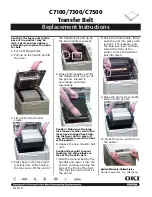
12
unnecessarily remove too much of the abrasive surface – wearing the disks prematurely. If that
should occur, factory replacement of the disks will become necessary. If you clean your knives
regularly before sharpening you will likely need to clean or dress the Stage 3
disks
no more than
once a year.
SuggeStIonS
1. Always clean all food, fat and foreign materials from the blade surfaces before sharpening
or resharpening. If badly soiled, use detergent and water to clean then dry knife thoroughly.
2. Always pull the blades at the recommended speed and at a constant rate over length of
blade. Never interrupt or stop the motion of the blade when in contact with abrasive disks.
3. Carefully follow the detailed procedures for each type blade for best results and to extend
the useful life of your knives.
4 The edge of the knife blade, while sharpening, should remain in contact with the abrasive
disks as the knife is withdrawn from the guiding slot. To sharpen the blade near the tip of a
curved blade, lift the handle up
slightly
as you approach the tip of the blade but just enough
so that the edge as it is being sharpened maintains audible contact with the sharpening or
polishing disk.
5. To increase your proficiency with the Chef’sChoice
®
Ceramic
+ Steel Model 700, learn how
to detect a burr along the edge of a steel knife (as described on page 7 and 8). While you
might be able to sharpen well without using this technique, it is the fastest way to determine
when you have sharpened sufficiently in the preliminary steps. This will help you avoid
oversharpening and ensure incredibly sharp edges every time. Cutting a tomato or a piece of
paper is a convenient method of checking for finished blade sharpness.
6. Use only light downward pressure when sharpening – just enough to establish secure
contact with the abrasive disk.
7. If your knife has a significant choil you may find it helpful to place your index finger within
or just behind the choil (see Figure 16) as you insert the blade in the sharpener. (Be careful,
Figure 16. If your blade has a significant choil it
may be helpful to place a finger behind it as shown
when sharpening.
Choil













































